|
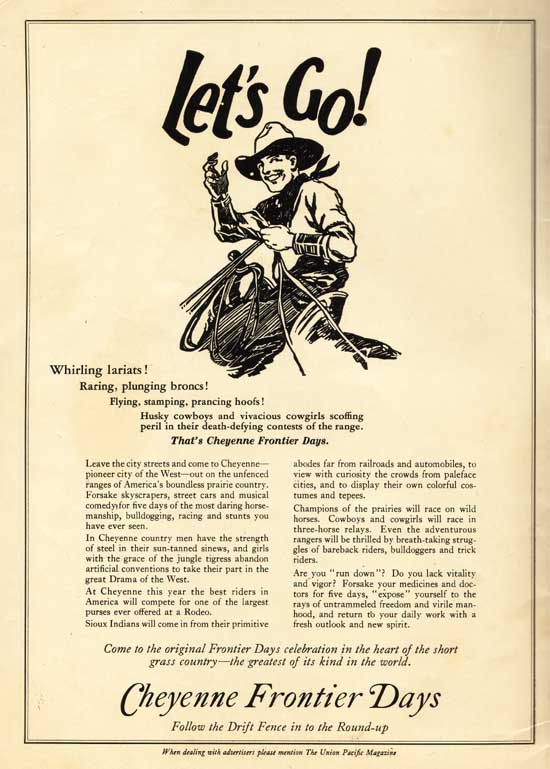
Frontier Days Advertisement, Union Pacific Magazine, July 1929.
Rodeos themselves date back to the era of the great cattle drives.
Although both North Platte, Neb. and Prescott, Ariz. each claim to have had
the first rodeo, in actuality, Deer Trail, Colo., has a better claim. Riders from
the Campstool, Mill Iron and Hashknife Ranches competed in a bronco riding contest on July 4, 1869. The
contest was won by a Mill Iron rider, Emilnie Gardenshire, riding a Hashknife bronco named
Montana Blizzard. Gardenshire won a suit of clothes donated by a Denver dry goods store and the
title "Champion Bronco Buster of the Plains." The Campstool lives on in the name of
Campstool Road in Cheyenne.
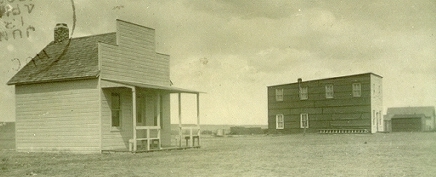
Campstool Ranch, 1909
The Campstool Ranch was located about 13 miles east of
Cheyenne along Crow Creek next to the abandoned Burlington right-of-way to Sterling. The
ranch was formed by Daniel Ullman who moved to Cheyenne about 1869 from Denver where
he operated a meat market on Blake Street.
 The move may have led to the breakup
of Ullman's marriage. Ullman's wife, Harriet refused to move to Cheyenne and
stayed in Denver where she owned and operated a "disorderly house." The 1880 Denver
census describes her as "keeping house" and as being divorced. Except for
two servants, no occupation is given for the remaining inmates of the household. Not withstanding the
claimed divorce, upon Ullman's death in 1896, Mrs. Ullman showed up in
Cheyenne and attempted unsuccessfully to claim a widow's homestead interest in
Ullman's property.
The move may have led to the breakup
of Ullman's marriage. Ullman's wife, Harriet refused to move to Cheyenne and
stayed in Denver where she owned and operated a "disorderly house." The 1880 Denver
census describes her as "keeping house" and as being divorced. Except for
two servants, no occupation is given for the remaining inmates of the household. Not withstanding the
claimed divorce, upon Ullman's death in 1896, Mrs. Ullman showed up in
Cheyenne and attempted unsuccessfully to claim a widow's homestead interest in
Ullman's property.
In 1903 President Roosevelt made an extended visit
to Wyoming. As a part of the trip he rode horseback from Laramie to
Cheyenne, beating the rains which came the next day. That evening, he made a speech in front of the
courthouse. Later, Senator Warren presented him with a horse and saddle. Roosevelt named the
horse Wyoming.
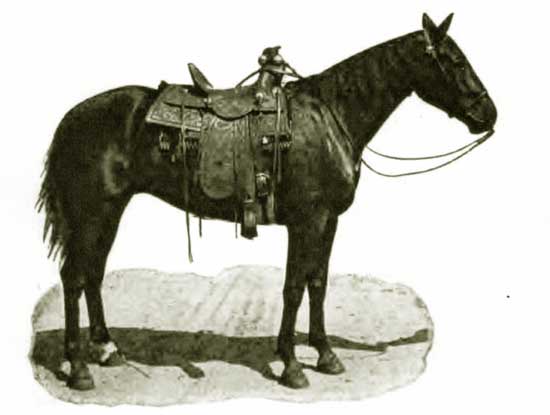
Wyoming, Horse and Saddle presented to President
Roosevelt, 1903.
Wyoming was a bit spirited and President Roosevelt would not allow Mrs. Roosevelt to ride the
horse, although his children could. Later in the year G. W. Gettys of Newcastle presented President
Roosevelt a hand made goat hair cinch for use with the horse.
On April 25, Roosevelt made train stops in Gillette and Moorcroft. For further discussion of
President Roosevelt's 1903 trip to Wyoming, see Yellowstone.
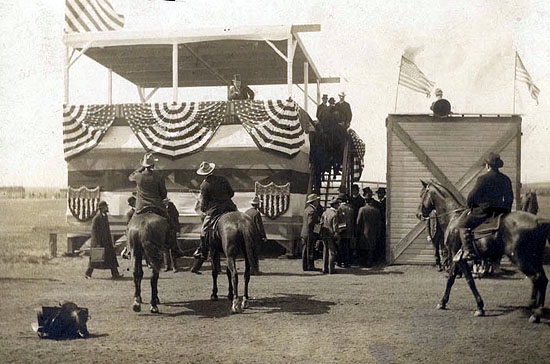
President Theodore Roosevelt, Cheyenne, 1903
As a part of the festivities, a special one-day rodeo was put on for Roosevelt.
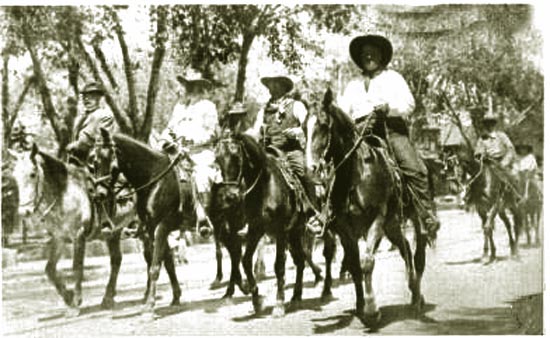
Left to Right: President Roosevelt, William F. Cody,
Amos W. Barber, Charles B. Irwin. Cheyenne, 1903
Roosevelt's
visit was not, however, the first visit by a sitting president. Although Gen. Grant visited Wyoming as a
candidate for president, he did not come during his presidency. To that honor belongs
Rutherford B. Hayes in 1880. When the presidential train pulled into Cheyenne, a 38-gun salute, one for each state in the
Union, was given The President and his entourage was welcomed by Gov. John Hoyt. The President's
visit, however, to Fort D. A. Russell was less memorable. Gen. Albert G. Brackett was not at the
post but was in town instead. No arrangements had been made for any kind of reception for
the President, Secretary of War Alexander Ramsey, and Gen. Sherman. The departure of the presidential
train was delayed while the President's son, Rutherford P. "Rud" Hayes, visited the
barbershop at the Inter-Ocean Hotel.
For most of the presidential journey, Hayes was welcomed. Union veterans would
gather along the tracks awaiting the arrival of the presidential train. The veterans would stand at attention and
salute as the train, cinders flying,
roared by sometimes at speeds as great as 35 miles per hour. Stops were made at Fort Sanders and Laramie City. In Laramie City, the President and
Secretary Ramsey gave remarks. The train paused late at night at Fort Steele where Gen. Sherman and Secretary
Ramsey greeted the officers. As the train passed Rawlins without stopping, however, the party was greeted by demonstrations. Gen. Sherman, who made arrangements
for the trip, acted as a tour guide pointing out landmarks including the
great charcoal kilns at Hilliard. In Evanston the train paused to change engines. There, the citizenry had prepared a
breakfast in honor of the Commander-in-Chief, but, it being Sunday, he declined the invitation. The party continued on
through Utah, Nevada, and ended in California. In California, part of the President's visit included
a tour of parts of the state by stagecoach. There, because of danger from road agents and there being no
Secret Service, Gen. Sherman, himself, rode shotgun.
[Writer's note, the image of the Union veterans by the tracks reminds the writer of the story told by
Malcolm Johnson, who, as a little boy, lived on the plains of Alberta at the time of the visit by
the Prince of Wales, later Edward VIII. The town had learned that the Royal Train was to pass
through. The town band and the populace gathered by the tracks to see the Prince, their Prince. In the distance the smoke from
the train was seen. While the train roared by without slowing down, the band struck up God Save the King. And as the train receded into
the distance, a small figure on the rear platform was seen waving.]
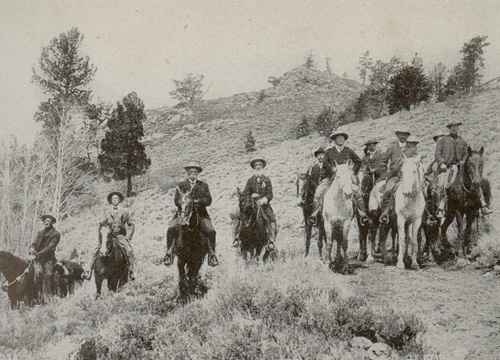
Pres. Theodore Roosevelt and party, riding from
Laramie to Cheyenne, Telephone Canyon, May 1903, photo believed by
B. C. Buffum.
Others in photo include N. K Boswell, first sheriff of Albany County (center background with beard); United States
senator and former governor, F. E. Warren (on right in photo, see photo to lower left); and
Van Ransselaer Schuyler Van Tassell, Goshen County rancher. Bert C. Buffum (1868-1944), to
whom the photograph is attributed, was professor of agriculture at the
University of Wyoming and director of the Agricultural Experiment Station from
1902 until 1907 and was an advocate of "dry farming." The 1903 ride was not the only extended
ride made by Roosevelt on the political trails in Wyoming. In 1910, Col. Roosevelt rode the approximately 35 miles out to the
Warren Ranch. Local cowboys speculated between themselves as to whether Roosevelt would ride back that night.
He came back by motorcar. When confronted by the cowboys, Roosevelt protested that he used the
car at the insistance of Senator Warren who did not want his guest riding back to Cheyenne by horse in the
dark.
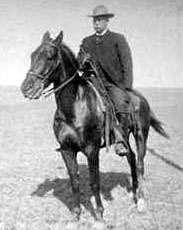
F. E. Warren on Roosevelt Ride, 1903.
The following year, national attention was again directed to Cheyenne with the
spectacular performance by black cowboy Willie M. "Will" Pickett (1870-1932). Pickett
is generally credited for having single-handedly invented the Bulldogging contest.
Pickett, as a cowboy, had observed that cowdogs would sometimes bring a steer down by biting the
steer on the muzzle. Thus, Pickett had a unique method described in the Wyoming Tribune. Pickett would
"attack a fiery, wild-eyed and powerful steer, dash
under the broad breast of the great brute, turn and sink his strong ivory
teeth into the upper lip of the animal, and throwing his shoulder against
the neck of the steer, strain and twist until the animal, with its head
drawn one way under the controlling influence of those merciless teeth
and its body forced another, until the brute, under the strain of slowly
bending neck, quivered, trembled and then sank to the ground."
Pickett's performance also came to the attention of Harper's Weekly where it was
reported nationally. Pickett also came to the attention of the Miller Bros.
101 wild west show who offered Pickett a role. Harper's reported:
"20,000 people watched with wonder and admiration, a mere man, unarmed and without
a device or appliance of any kind, attack a fiery, wild-eyed, and
powerful steer and throw it by his teeth."
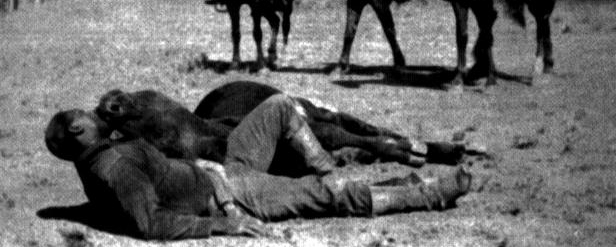
Will Pickett downing steer with teeth, undated
With the 101, Pickett performed with Tom Mix and Will Rogers and also performed for
Queen Alexandra. He was also allowed to travel on the show's train in the passenger
cars rather than travelling in the cattle cars where blacks typically rode. When Pickett died in
1932, Will Rogers interrupted his national radio program to give a personal
eulogy. Pickett was the first black to be inducted into the Rodeo Cowboy Hall of
Fame.
At first the Frontier Day parade consisted merely of cowboys racing down the street, perhaps
scaring women, children and dogs.
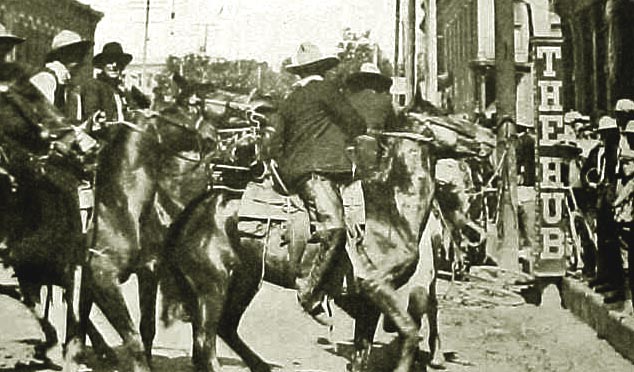
Cowboys, Frontier Day, 1904.
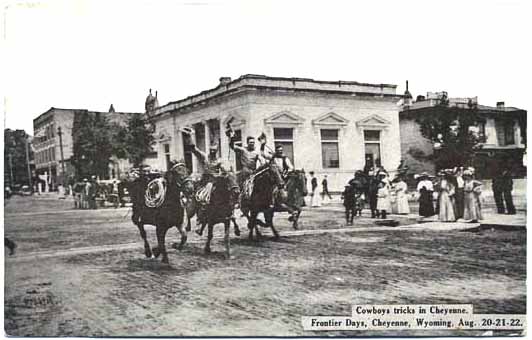
Cowboys in front of Stockgrowers' Bank, 1908.
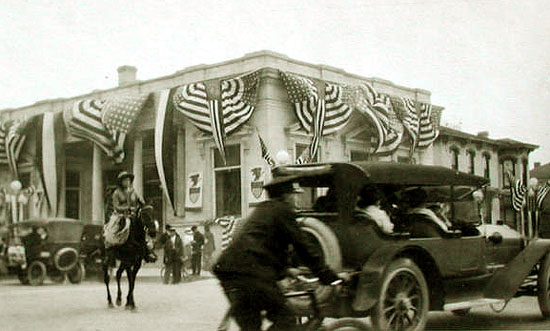
Cowboy in front of Stockgrowers' Bank, 1914.
Gradually the parade became more formal.
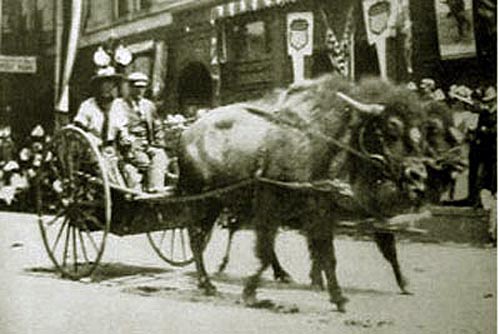
Frontier Day Parade, 1910.
Trained bison, named Scotty and Pete, were grown by Charlie Irwin, the stock contractor for Frontier Day and proporietor of
the Irwin Brothers Wild West Show.
Next page, Frontier Days continued.
|